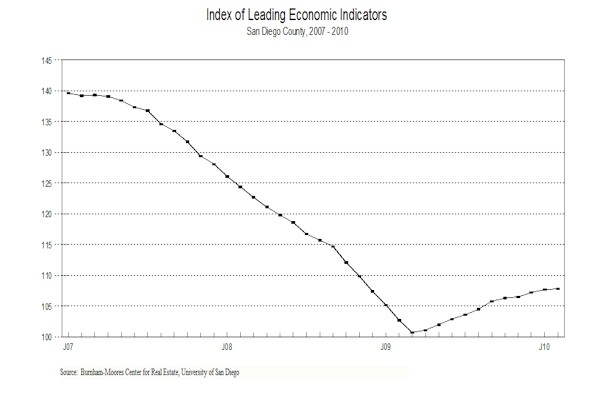|
Home
Leading Economic Indicators
Up Slightly in February
Note:
The tentative release date for next month's report is April 27.
March 25, 2010 -- The
University of San Diego's Index of Leading Economic Indicators for San Diego
County rose 0.1 percent in February. The month saw moderate gains in building
permits, initial claims for unemployment insurance, and help wanted advertising,
as well as a smaller increase in the outlook for the national economy. These
outweighed declines in local stock prices and consumer confidence to push the
USD Index to its 11th straight monthly increase. February's gain
however was the smallest in those 11 months.
 |
Index of Leading Economic
Indicators
The index for San Diego County that includes the
components listed below (February)
Source: University of San Diego |
+ 0.1 % |
 |
Building Permits
Residential units authorized by building
permits in San Diego County (February)
Source: Construction Industry Research
Board |
+ 0.84% |
 |
Unemployment Insurance
Initial claims for unemployment insurance in San Diego County, inverted,
estimated (February)
Source: Employment Development Department |
+ 0.69% |
 |
Stock Prices
San Diego Stock Exchange Index (February)
Source:
San Diego Daily Transcript |
- 0.75% |
 |
Consumer Confidence
An index of consumer confidence in San
Diego County (February)
Source:
San Diego Union-Tribune |
- 0.64% |
 |
Help Wanted Advertising
An index of online help wanted advertising in
San Diego (February)
Source: Monster Worldwide |
+ 0.53% |
 |
National Economy
Index of Leading Economic Indicators (February)
Source: The Conference Board |
+ 0.18% |
After unprecedented
volatility for the last couple of years, the USD Index has "settled down," with
no major change in any component in either direction for the last two months.
The outlook then remains for positive but slow growth for the local economy for
the year ahead. The growth may be uneven, with occasional setbacks. One
potential problem is the budgetary difficulties faced by the state and by local
governments. Due to requirements to have balanced budgets, state and local
governments either have to raise taxes or cut jobs and spending or both, which
makes a bad economic situation worse. Other things to keep a watch for are
another wave of foreclosures due to the severe job losses in the local economy
and weakness in commercial real estate, where a glut of retail and office space
is putting pressure on commercial real estate owners and their lenders.
Highlights: January and February of 2009 were
the two worst months ever for residential units authorized by building
permits. The first two months of 2010 have not been great by historical
standards, but residential units authorized are more than triple what they were
the year before. . . There continues to be good news in terms of the labor
market components. The rate of job loss continues to fall as measured by
initial claims for unemployment insurance. Unfortunately, something not
measured in the index is that filings for extended unemployment benefits through
various federal programs remains very high as people have been unemployed for
much longer periods than in the past. On the other side of the labor market,
help wanted advertising now has a modest four month positive streak, after
having fallen for 38 months in a row. This good news has not yet translated into
improvements in the employment situation, with the local unemployment rate
hitting 11 percent in January, a new high for this downturn. . . Local
consumer confidence registered its second straight loss in February. After
rebounding sharply from an all-time low in March of last year, local consumer
confidence has hit a plateau as local consumers wait for better news on the
employment front. . . Local stock prices turned negative as investors
remain concerned about the strength of the recovery and the possibility of a
"double dip" recession. . . The national Index of Leading Economic Indicators
has mirrored the performance of the local index by also rising for 11
consecutive months. Although the end of the "Great Recession" has not yet been
declared, there are signs that the national economy may already be on the
rebound. Gross Domestic Product (GDP) grew at a 5.9 percent annual rate in the 4th
quarter of 2009, the strongest quarterly growth since 2003.
February's increase puts the USD Index of Leading Economic
Indicators for San Diego County at 107.8, up from January's revised reading of
107.7. Changes in all the components, but most notably initial claims for
unemployment insurance, led to a revision in the previously reported change and
level of the Index for January. Please visit the Website address given below to
see the revised changes for the individual components. The values for the USD
Index for the last year are given below:

For more information on the University of San Diego's Index of Leading
Economic Indicators, please contact:
|